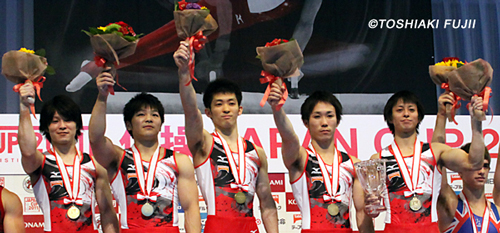Japan Cup 2011 – Team Finals
 Doha (QAT), AGU office, July 7, 2011: This year’s Japan Cup has two strong objets: the last test event for the coming world championships and the one of the big international sport events for Tokyo after the earthquake. Thus the competition will be exciting and encouraging not only the gymnasts but also the people in Tokyo!
Doha (QAT), AGU office, July 7, 2011: This year’s Japan Cup has two strong objets: the last test event for the coming world championships and the one of the big international sport events for Tokyo after the earthquake. Thus the competition will be exciting and encouraging not only the gymnasts but also the people in Tokyo!
Men’s Team Competition
All the eight countries were thrilled by the 5-3-3 format of the team competition, which will be the same format in the team final at the2012 Olympics; they made a lot of mistakes on every event, especially parallel bars, and those mistakes made the medal contention dramatic.
Japan sent their best team to the competition as the host country, but they had major mistakes on most of the events. Kenya Kobayashiand Kazuhito Tanaka had falls on pommel horse, and Makoto Okiguchi crawled on the landing of his Lopez vault. Koji Yamamuro wobbled on his handstand on parallel bars.
Those errors gave an unexpected small margin to China, who sent their inexperienced gymnasts, placing first after the fifth rotation. In the last rotation, Kobayashi fell twice on horizontal bar, butTanaka and Kohei Uchimura, the reigning world champion, hit theirroutines perfectly and won their third consecutive team title. Uchimura made no mistake on his three events, nailing his landings onvault and horizontal bar.
China, the United States and Great Britain were in keen contention; China placed second after the fifth rotation, led by Liao Qinhua, buton horizontal bar in the last rotation, there were critical mistakesfrom two gymnasts: Tong Yingjie had 3 falls and scored only 11.250 and Liao had an extra swing after his Adler half to score 13.250. These two low scores cost them the medal. In contrast, the United States, who placed third after the fifth rotation, had high enough scores to save their rank on floor even though Jonathan Horton and Danell Leyva struggled on their landings. As a result, 15.800 from Steve Legendre brought them a silver medal. Great Britain was in the same group as the United States, and they also got great scores on floor in the last rotation. Their second best total score took them ahead of China and brought a bronze medal.
Women’s Team Competition
Placing fifth at the last world championships, Japan challenged Chinawith their best team (including Koko Tsurumi and Rie Tanaka) for their first team title of the Japan Cup. China left home Cheng Fei, agold medal-winning member of 2008 Olympics team, but they still sent a strong team.
Japan started the competiton with China on vault, but Asuka Teramoto, a new comer for Japan, performed an unplanned Yurchenko-full (it was supposed to be a double twisting Yurchenko), which cost Japan nearly one point. China, in contrast, had a big mistake on uneven barsin the second rotation; Sui Lu had an extra swing after her Park,which gave her a big deduction. After the second rotation, Japan came within .2 to China.
China, however, performed their world-class routines on beam and floorand gained more lead over Japan. Japan also hit their routines but lower D and E scores cost them the title. Eventually, China won their second Japan Cup title.
Australia and Canada were supposed to be in medal contention but Australia made some critical mistakes and got bad scores on every event except vault. The reigning world champion on floor, Lauren Mitchell, had uncharacteristic wobbles on beam and floor (her new floor routine was in the Spanish style to ‘Besame Mucho’). She could not lead her team well and they ended up out of medal position.
Canada, in contrast, showed strength on vault and floor, on both of which they scored the second best total. On floor, their choreography was extremely impressive and attracted the crowd. In the last rotation, they had two double twisting Yurchenkos and gained good scores to grab a bronze medal.
From JGA by Toshiaki Fujii